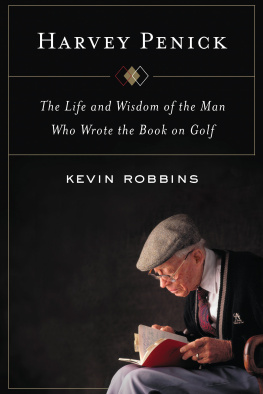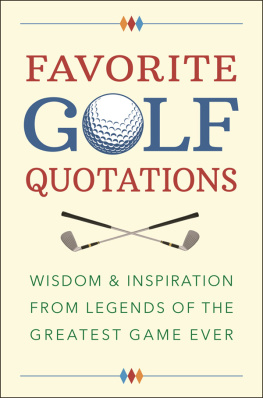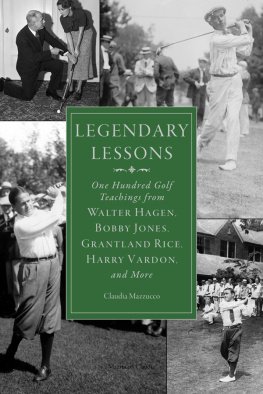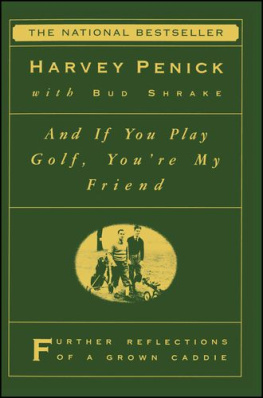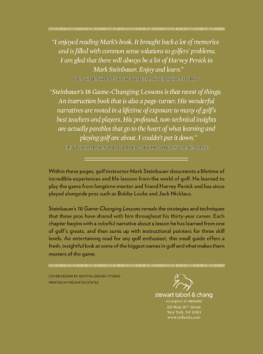Copyright 2016 by Kevin Robbins
All rights reserved
For information about permission to reproduce selections from this book, write to or to Permissions, Houghton Mifflin Harcourt Publishing Company, 3 Park Avenue, 19th Floor, New York, New York 10016.
www.hmhco.com
The Library of Congress has cataloged the print edition as follows:
Names: Robbins, Kevin.
Title: Harvey Penick : the life and wisdom of the man who wrote the book on golf / Kevin Robbins.
Description: Boston : Houghton Mifflin Harcourt, [2016]
Includes bibliographical references and index.
Identifiers: LCCN 2015037555 | ISBN 9780544148499 (hardcover)
ISBN 9780544149076 (ebook)
Subjects: LCSH : Penick, Harvey. | Golf coachesUnited StatesBiography.
Classification: LCC GV 964. P 44 R 64 2016 | DDC 796.352092dc23
LC record available at http://lccn.loc.gov/2015037555
Excerpts from Harvey Penicks correspondence are courtesy of the Harvey and Tinsley Penick Collection, Stark Center, University of Texas.
Cover design by Martha Kennedy
Cover photograph Dom Furore
v1.0416
For Suzy
What is it about Harvey that the world fell in love with? I think it was his spirit. He was always wisely powerful, always positive. Harvey spoke in simple words, and if you listened, sooner or later you understood.
BUD SHRAKE , at the funeral for Harvey Penick, April 5, 1995
Introduction
ON A STICKY Texas morning in the late summer of 2013, the only son of Harvey Morrison Penick settled into a heavy wooden chair and prepared to trace the arc of time. He sat less than two miles from where his father once had an epiphany, then thought to buy a cheap notebook, fetch a ballpoint pen, and sit down to write.
Tinsley Penick unraveled a button-and-clasp archival box that September morning with long, curved fingers. They were the fingers of a golfer, just like those of his dad, and those of the many champions who absorbed their swingcraft from Harveys short, infrequent, yet potent words. At seventy-five, Tinsley resembled his late father in sharp silhouette: tall, lean, brittle, abrupt joints, a frame bent at the hips in a posture of modest supplication. But he most evoked Harvey in the length of his face, which carried the same narrow nose and crisp, gentle, topaz eyes that had seemed to parse the movement of a golf swing at the level of an atom.
Let me get my glasses, Tinsley said.
There was no sound but his airy voice that morning in the H.J. Lutcher Stark Center for Physical Culture and Sports, a gallery space and research facility on the fifth floor of Darrell K RoyalTexas Memorial Stadium in Austin. The box he prepared to open held the notebook that his father maintained for more than half of the twentieth century. No one knows precisely when Harvey began recording his notes, but it was certainly sometime in the early 1930s, more than a decade after he became, at the age of eighteen, the first Texas-born golf professional. No one knows when he wrote his last note either.
Yet millions of people around the world now know the essence of those words left in dainty strokes of ink. They are some of the most famous observations about golf in the history of the ancient game. Theyre the ideas that became Harvey Penicks Little Red Book and four subsequent titlesnot counting a twentieth-anniversary edition of the original published the year Tinsley met with me on the campus of the University of Texas to page through the 6,365 words in the Scribbletex notebook together for the first time.
This project began, in a circular way, on Christmas Day 1992. I wasnt much of a golfer then. But I did hope to become one, and that connected me to Harvey and his book.
My maternal grandmother, a kindly hairdresser named Lola Martin who played golf to an excessive handicap but found high joy in the random and wicked vagaries of the game, left the Little Red Book for me in bright wrapping paper under her hand-cut Christmas tree in Raytown, a suburb of Kansas City, Missouri. Its been with me through my many moves from city to city, from shelf to shelf, and finally to Texas.
Texas is where I did become the player I hoped to be. Its where I met Tom Kite and Ben Crenshaw and Tinsley Penick and the hundreds of other golfers who populate the sprawling tree of influence that Harvey left when he died quietly in his home as the sun set one April evening in 1995. I wish my grandmother could see me now, writing the early words of the first biography of Harvey. The last time I saw her, she was in a nursing home, where she had been for a long time, rendered infirm by a series of strokes. When she became so frail that my mother summoned the family home to Missouri, the grandchildren took turns sitting at her bedside overnight so our grandmother would not be alone. It was my night to sit when she died, with my hand resting on her arm.
From Grandma Martin, she had written inside the cover of my Little Red Book. The book became my bellwether, not only because my grandmother had given it to me, but because, to me and millions like me, it felt like a sacred text, close to holy for anyone who wants to play in the fewest swings and divine the richest pleasures of the game. Ive read those 175 pages so often that the spine of the book has begun to disintegrate, and now its as delicate as an old rubber band. I can tell which of the seventy-nine tiny chapterscall them lessons if you wishresonated most with me in 1992. I marked them with an X in red ink on the table of contents. The most important ones got two.
All of these things in here Ive heard many, many times, Tinsley said as he followed his fathers words with his fingernail. We were halfway through the notebook, and Id been watching for about an hour as Tinsley traced the blue-lined pages. Years after Harveys death, the Penick family donated to the Stark Center the many cardboard boxes of newspaper clippings, interview transcripts, magazine stories, photographs, relics, books, albums, audio recordings, and videotapes they had collected about Harvey. The family had curated the life of a man who rarely left the tight radius enveloping the home where he was born, the four other houses he owned, the three Austin Country Club locations where he taught, and the plot where he is buried under a wide Texas live oak, marked by a modest stone where people leave golf balls for the caretakers to collect. But the boxes in the Stark Center validate a monumental existence: Harveys reach in golf crossed continents and generations, and it is hard to imagine the birth of golf in the American Southwest taking place without him.
Tinsley and I talked some, but mostly we just read together in silence, as people do with priceless texts in museums. We paused at a page near the back, where Harvey had noted in the light lead of a pencil an observation that his pupil Kathy Whitworth, who won a record eighty-eight times on the LPGA Tour, had once shared with the Dallas Morning News.
Harvey was to me what Merlin was to King Arthur, the shaky cursive read.
This is a story about a Merlin and his vast court of King Arthurs.
Tinsley introduced himself to me at the door of his house in early 2005. He had invited me to his house in the hills of northwest Austin, where he lived in retirement with his cheerful wife, Betty Ann, to tell me about Harvey. We sat in the bright sunlight of their living room and talked for a story I was preparing to mark the tenth anniversary of his fathers death, which was a solemn occasion in Austin, the city that still loved him and always will.
I told Tinsley about my grandmother. I told him about the marks in my Little Red Book. I revealed to him that I thought his father meant as much to modern golf as carbon means to the universe, because Id already written this line, even before the first interview: In death, Penick lives.
Next page
